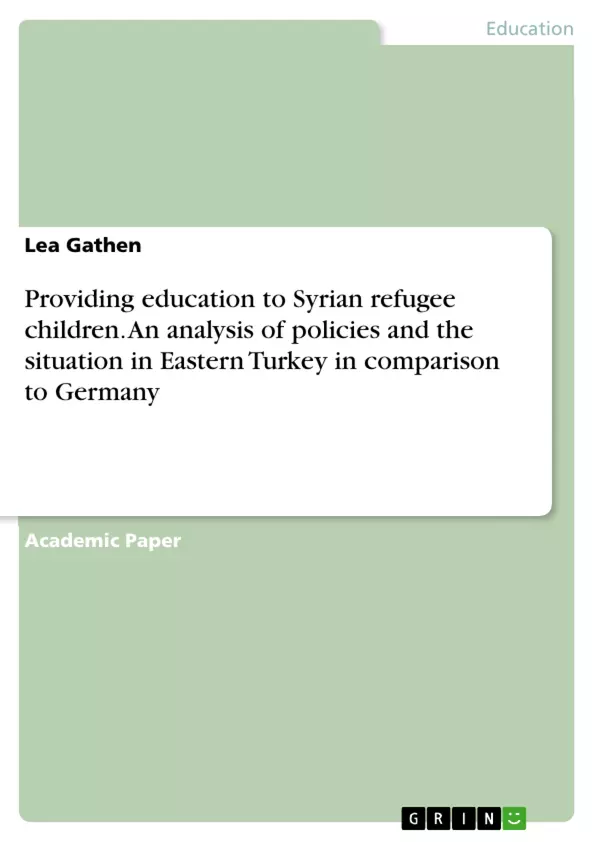There are more than 2.7 million Syrian refugees living in Turkey (BMZ, 2016). Since more than half of Syrian refugees in Turkey are children (Yavcan & el Ghali, 2017), the high number of refugees is placing demands on public institutions. Several temporary systems for providing education are in place, but only a small part of children enrolled into educational programs attend regular schools. Providing access to education, therefore proves to be a major challenge for policy makers in Turkey. This report explores the situation in Eastern Turkey, with a focus on policies, which are contrasted with German integration policies and reference points from Berlin and Munich.
Inhaltsverzeichnis (Table of Contents)
- INTRODUCTION
- BACKGROUND OF THE ISSUE
- CONSEQUENCES OF THE SYRIAN WAR
- THE CHALLENGE OF PROVIDING EDUCATION TO REFUGEE CHILDREN
- EDUCATIONAL POLICIES
- THEORETICAL INTRODUCTION
- TURKEY
- GERMANY
- CASE STUDIES
- THE SITUATION AT SCHOOL IN EASTERN TURKEY
- INTEGRATION OF REFUGEES IN BERLIN, JENA AND MUNICH (GERMANY)
- CONCLUSION AND PERSPECTIVES
- SHORT BIOGRAPHY OF AUTHOR
- REFERENCES
Zielsetzung und Themenschwerpunkte (Objectives and Key Themes)
This analysis examines the challenges of providing education to Syrian refugee children in Turkey, comparing the situation to that of Germany, with a particular focus on integration policies. The research aims to identify potential areas for policy improvement in Turkey regarding refugee education.
- The impact of the Syrian war on the education of Syrian refugee children
- The challenges and opportunities of integrating Syrian refugee children into the Turkish and German education systems
- The role of policies in providing education to Syrian refugee children
- The importance of cultural sensitivity in refugee education
- The need for a holistic approach to refugee integration, including education, employment, and social integration
Zusammenfassung der Kapitel (Chapter Summaries)
- Introduction: The paper introduces the critical issue of providing education to Syrian refugee children in Turkey and presents the research question: what are opportunities for policy improvement in Turkey when facing the current issues of providing Syrian refugee children with education?
- Background of the Issue: This chapter outlines the Syrian civil war's consequences, including displacement and the resulting pressures on Turkey's resources and infrastructure. The chapter explores the legal status of Syrian refugees in Turkey and discusses the importance of education as a fundamental human right.
- Consequences of the Syrian War: This chapter examines the lasting impact of the Syrian war, including the loss of life, displacement, and the resulting burden on Turkey's resources.
- The Challenge of Providing Education to Refugee Children: This chapter explores the challenges of providing education to refugee children in Turkey. It presents statistics on the number of school-aged Syrian children and discusses the challenges of providing education within refugee camps, non-formal education programs, and the integration into regular schools.
Schlüsselwörter (Keywords)
This research explores key themes of refugee education, integration policies, intercultural understanding, educational access, and the challenges of providing education in a multicultural context. It delves into the complexities of providing education to Syrian refugee children in Turkey, analyzing existing policies and drawing comparisons to German integration models. Specific focus areas include the impact of the Syrian war, challenges in providing education in refugee camps and regular schools, and the importance of cultural sensitivity in educational settings.
- Quote paper
- Lea Gathen (Author), 2019, Providing education to Syrian refugee children. An analysis of policies and the situation in Eastern Turkey in comparison to Germany, Munich, GRIN Verlag, https://www.grin.com/document/459320



